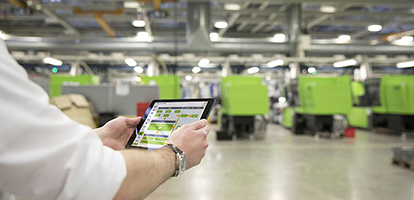


Industry 4.0 and big data open up unexpected possibilities for manufacturers and lay the groundwork for promising business models – therefore, increased data protection is necessary. Flexible and intelligent technical solutions that collect data at the field level and provide it to the cloud will establish this foundation.
Networking continues to increase. Whether one considers smart houses, mobility or production, everything is networked and constantly provides data about the environment and processes. Software updates are implemented “through the ether,” which eliminates the need for extensive maintenance or a trip to the repair shop, an example already shown by the eVehicle pioneer Tesla. Against this background, product development in the future will not stop at delivery, but will transform into a constant process – a decades-old convention in the software industry in which the key term is Continuous Delivery. Manufacturing will thus develop into a constant process, which will also continue after product delivery and must, therefore, be configured. The infrastructure in the background provides both the foundation for a long and maintenance-free service life of the product, and must also be constantly adapted and optimized. Every day, the world is becoming a little bit more digital. The increasing speed of development cycles correspondingly demands agile solutions on the part of companies in order to remain competitive over the long term. Flexibility sells!
IIoT* – The “System of Systems”
Digitalization concepts, like Industry 4.0 in production, can create the necessary flexibility. Queries, which were previously processed in different machines and systems, will in the future be autonomously answered by a “system of systems,” the network of product, process and resources. What should be produced in what amounts? Are replacement parts or materials needed? When should the delivery occur? This can even go a step further: In the factory of the future, all components in the production chain will be able to autonomously communicate with one another – across locations. The goal is networked production that is faster, more efficient, and more flexible, enabling individualized products while retaining high quality. The classic automation pyramid using conventional central controllers is gradually disappearing.
New information and communication technologies, like cloud services, 5G, OPC-UA with TSN, and flexible automation solutions are the future of Industry 4.0 and IIoT. These solutions are the object of increasing attention for linking machine-to-machine communication, as well as networking machines with the entire organization to process and analyze newly gained information density. Only in this way can the new optimization potentials be leveraged. These communication technologies enable monitoring, tracing and controlling of production processes via remote access. Examples include condition monitoring and predictive maintenance.
Added Value through New Business Models
Previously, personnel, technology and capital were the critical factors for commercial business: now, data must also be included. However, while individual measured values are rather meaningless, the combination and contextualization of thousands of data sets within the framework of big data analytics allows for pattern recognition. The much-invoked added value thereby arises from the combination of different data sets, for example, the derivation of optimization potentials and predictions for processes. The possibilities are extensive, from energy management solutions through easy remote diagnostics up to predictive maintenance. Their potential for corporations extends past mere internal use. The success rate for these types of technological solutions is already quite promising – leading to higher production efficiencies and reduced operating costs. The evaluation and use of data has increasingly developed into an external competitive advantage. One thing should have become clear by now: The road to created value passes through these data. However, many companies use only a fraction of the available data. According to one example from the McKinsey study, “How to navigate digitization of the manufacturing sector,” less than one percent of the data generated by the approximately 30,000 sensors on a drilling rig are used to make decisions. Even in the automation sector, data are used almost exclusively for real-time applications and for fault detection. Yet, before they can even be used, they have to be available. The road to created value therefore also passes through the cloud. Yet how are our domestic corporations positioned with respect to the cloud? An answer appears in the “Cloud Monitor” compiled by Bitkom Research and KPMG: 65% of companies surveyed in the machine and system engineering sector were already using cloud computing. For 76%, the location of the server farms in Germany was a decisive criterion.
On the Road to Success with Smart Solutions
The cloud is an essential technological “enabler” of Industry 4.0 and IIoT, providing inexpensive and easily scalable computing and storage capacities beyond one’s own IT systems. It is a central component of the required technological infrastructure – the “technology stacks.” After all, every smart product in the “Internet of Things” has three core elements in common: a physical component (mechanical or electronic parts), intelligent components (sensors, processors, or control units), and networking components (ports or antennas). “This triad opens up completely new application possibilities: for example, products that monitor themselves and their surroundings, provide insights into usage and features, and can be controlled by the user through remote access, for example, via mobile devices,” explains Leon Urbas, Professor for Process Control Technology at the Institute for Automation Technology at the Technical University of Dresden. This combination in turn offers the potential for optimization and potential for further automation, because ad hoc adjustments are also possible due to remote maintenance. Consequently, the equation reads: Data control + remote control + optimization = automation. WAGO’s PFC family of controllers form the link between the real and digital worlds. With their PFC controllers, WAGO offers harmonized software solutions, services and platforms, that users will need in the future. This includes the decentralized data acquisition at the field level and automation, as well as providing data via the cloud to facilitate new data-driven business models. Cloud connectivity solutions from WAGO, like the PFC100 and PFC200 with MQTT interfaces, provide a sufficiently high security standard and a secure path to the cloud, for production and elsewhere.
The Cloud – Enabler for Industry 4.0 and IIoT
Industry 4.0 uses the cloud as more than just a data collection point. It provides the backbone of the production chain in connection with physical production systems. It supports product and production databases, analysis platforms for evaluating the production processes, and intelligent production application in order to automatically control and optimize production machines during operation. This information is enriched with company proprietary data from ERP, CRM, and PLM and external data, like raw material and energy costs, traffic situations, or weather data. For industry, the advantage of cloud services with respect to classic, in-house IT lies in a higher level of flexibility, particularly in relation to the scalability of systems. In addition, costs can be saved due to simplified administration, because cloud service providers offer standardized basic structures, like hardware, operating systems, and networks. Under certain circumstances, applications are managed by the service providers and enable the industrial companies to focus more precisely on their core competencies. This applies, regardless of company size, the number of existing servers, and the amount of data. In the long term, however, the only successful companieswill be those who work with each other, and not against each other, in their individual ecosystems. The trend of establishing proprietary platforms is already diminishing. Companies are beginning to seek cloud solutions that offer the greatest added value – which includes targeted collaboration with competitors. The goal: Developing services for all aspects of a product which all participants can use.
Cloud First – Security First
During the trend toward digitization, the cloud has become domesticated, it were, at consistently lower costs, due, to a large extent, to the variety of cloud services being offered. The reasons include the construction of large server farms and also increasing standardization through vendors like Microsoft, IBM, Amazon and Google. And yet many companies, primarily in the industrial production sector, still do not want to employ cloud services in their business processes.
The “Electrical Engineering and Information Technology 2015” report on trends published by VDE shows that doubts about IT security form a substantial barrier to cloud services, both for current business usage and for Industry 4.0. This is also confirmed by Bernd Steinkühler, CEO of Correct Power Institute in Bochum, a technical service provider for server farms, “In many companies, distrust of excessive networking is widespread. The skepticism is, however, often greater than the risk.” Security concerns remain the greatest obstacle to the use of cloud technology, and Industry 4.0 makes IT security increasingly complex. “When discussing security topics, the focus is often only on confidentiality. This is because legislators have consistently insisted that information, often defined as personal data, is “to be protected” from undesired access. However, when looking at Industry 4.0 and its massive information densities and IT networking, the scope of protection is extended to corporate proprietary expertise, like product information and machine configurations,” according to Steinkühler.
Protecting these unique selling points forms the central condition that must be met prior to the use of cloud services in production, and without impairing processes and quality. This is reflected by the 2016 VDE report: 58% of the surveyed companies indicated serious concerns about unauthorized access to sensitive corporate data. Some 45% reported the risk of data loss as a reason for increased skepticism. In the case of complete networking, corresponding security concepts must be established as a matter of course in each digitized corporate division.
However, security must extend beyond the responsibility of the IT department and must be comprehensively planned. The challenge of introducing cloud structures into production processes is not a technical problem, but is revealed as a strategic move. Therefore, a path must be selected which enables use of cloud technology advantages without sacrificing robust security measures.
Text: Thomas Holm and Nils Wigger I WAGO
Photo: WAGO